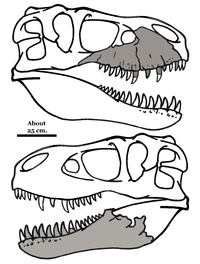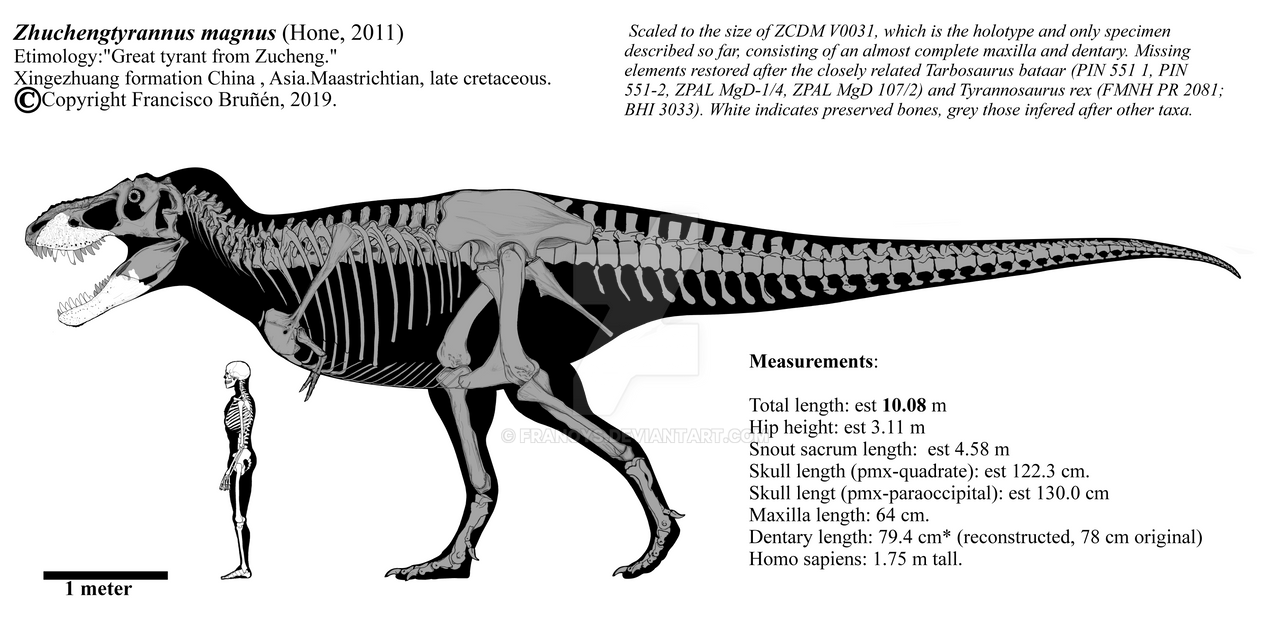Post by dinosauria101 on May 11, 2019 10:18:06 GMT 5
Zhuchengtyrannus magnus

Temporal range: Late Cretaceous, 70 Ma
Scientific classification
Kingdom: Animalia
Phylum: Chordata
Class: Reptilia
Superorder: Dinosauria
Order: Saurischia
Suborder: Theropoda
Family: Tyrannosauridae
Subfamily: Tyrannosaurinae
Genus:Zhuchengtyrannus
Species: Tyrannosaurus zhuchengensis
Zhuchengtyrannus (meaning "Zhucheng tyrant") is a genus of carnivorous theropod dinosaur from the Late Cretaceous period. It is a tyrannosaurine tyrannosaurid which lived during the late Cretaceous period in what is now Zhucheng, Shandong Province of China. It is known from a maxilla and associated dentary (lower jaw with teeth) recovered from the Wangshi Group, dating to about 70 million years ago. It was one of the largest known carnivorous theropods, measuring about 11 m (36 ft) in length and 4 metres (13 ft) in height. The dentary is only slightly smaller than the largest known Tyrannosaurus rex jawbone

The dinosaur was found in an area that was a flood plain in the Cretaceous period and which contains one of the highest concentrations of dinosaur bones in the world.
Classification and naming
The name "Zhuchengtyrannus" first appeared in an online manuscript by David W. E. Hone, Kebai Wang, Corwin Sullivan, Xijin Zhao, Shuqing Chen, Dunjin Li, Shuan Ji, Qiang Ji and Xing Xu in March 2011, with the type species "Z. magnus" (gen. et sp. nov.), though the name has not yet been formally published and is a nomen nudum.
It is possible that several isolated teeth from the same quarry, previously given the name Tyrannosaurus zhuchengensis, belong to this or a related species. The T. zhuchengensis teeth are characterized by serrations which extend all the way to the base of the tooth crown, a feature not seen in any other tyrannosaurine species. All known teeth of Zhuchengtyrannus are too poorly preserved in this area to compare with T. zhuchengensis, but further finds may clarify their relationship.
Size
Researchers estimate that Zhuchengtyrannus measured about 36 feet (11 meters) long, stood about 13 feet (4 meters) tall, and weighed close to 13,200 pounds (6,000 kilograms), the weight of a school bus.

Long Lost Cousin of T. Rex Identified by Scientists
ScienceDaily (Mar. 31, 2011) — Scientists have identified a new species of gigantic theropod dinosaur, a close relative of T. rex, from fossil skull and jaw bones discovered in China.
According to findings published online on April 1, 2011 in the scientific journal Cretaceous Research, the newly named dinosaur species Zhuchengtyrannus magnus probably measured about 11 metres long, stood about 4 metres tall, and weighed close to 6 tonnes.
Comparable in size and scale to the legendary T. rex, this new dinosaur is one of the largest theropod (carnivorous) dinosaurs ever identified by scientists.
Alongside T. rex and the Asian Tarbosaurus, Zhuchengtyrannus magnus is one of a specialised group of gigantic theropods called tyrannosaurines. The tyrannosaurines existed in North America and eastern Asia during the Late Cretaceous Period, which lasted from about 99 to 65 million years ago.
"Zhuchengtyrannus can be distinguished from other tyrannosaurines by a combination of unique features in the skull not seen in any other theropod," explains Dr David Hone from the UCD School of Biology and Environmental Science at University College Dublin, Ireland, the lead author of the scientific paper.
"With only some skull and jaw bones to work with, it is difficult to precisely gauge the overall size of this animal. But the bones we have are just a few centimetres smaller than the equivalent ones in the largest T. rex specimen. So there is no doubt that Zhuchengtyrannus was a huge tyrannosaurine."
"We named the new genus Zhuchengtyrannus magnus -- which means the 'Tyrant from Zhucheng' -- because the bones were found in the city of Zhucheng, in eastern China's Shandong Province," says Dr Hone.
A key member of the international team of scientists involved in the study is Professor Xu Xing of the Beijing Institute of Vertebrate Paleontology and Paleoanthropology in China. Professor Xu has named more than 30 dinosaurs, making him the world leader in describing new dinosaur species.
The tyrannosaurines, the group including T. rex and its closest relatives, were huge carnivores characterised by small arms, two-fingered hands, and large powerful jaws that could have delivered a powerful bone-crushing bite. They were likely both predators and scavengers.
Together with nearby sites, the quarry in Shandong Province, eastern China where the remains of this huge carnivore were found contains one of the largest concentrations of dinosaur bones in the world. Most of the specimens recovered from the quarry belong to a gigantic species of hadrosaur, or duck-billed dinosaur. Research suggests that the area contains so many dinosaur fossils because it was a large flood plain where many dinosaur bodies were washed together during floods and fossilised.
Journal Reference:
David W.E. Hone, Kebai Wang, Corwin Sullivan, Xijin Zhao, Shuqing Chen, Dunjin Li, Shuan Ji, Qiang Ji, Xing Xu. A new tyrannosaurine theropod, Zhuchengtyrannus magnus is named based on a maxilla and dentary. Cretaceous Research, 2011; DOI: 10.1016/j.cretres.2011.03.005

Temporal range: Late Cretaceous, 70 Ma
Scientific classification
Kingdom: Animalia
Phylum: Chordata
Class: Reptilia
Superorder: Dinosauria
Order: Saurischia
Suborder: Theropoda
Family: Tyrannosauridae
Subfamily: Tyrannosaurinae
Genus:Zhuchengtyrannus
Species: Tyrannosaurus zhuchengensis
Zhuchengtyrannus (meaning "Zhucheng tyrant") is a genus of carnivorous theropod dinosaur from the Late Cretaceous period. It is a tyrannosaurine tyrannosaurid which lived during the late Cretaceous period in what is now Zhucheng, Shandong Province of China. It is known from a maxilla and associated dentary (lower jaw with teeth) recovered from the Wangshi Group, dating to about 70 million years ago. It was one of the largest known carnivorous theropods, measuring about 11 m (36 ft) in length and 4 metres (13 ft) in height. The dentary is only slightly smaller than the largest known Tyrannosaurus rex jawbone

The dinosaur was found in an area that was a flood plain in the Cretaceous period and which contains one of the highest concentrations of dinosaur bones in the world.
Classification and naming
The name "Zhuchengtyrannus" first appeared in an online manuscript by David W. E. Hone, Kebai Wang, Corwin Sullivan, Xijin Zhao, Shuqing Chen, Dunjin Li, Shuan Ji, Qiang Ji and Xing Xu in March 2011, with the type species "Z. magnus" (gen. et sp. nov.), though the name has not yet been formally published and is a nomen nudum.
It is possible that several isolated teeth from the same quarry, previously given the name Tyrannosaurus zhuchengensis, belong to this or a related species. The T. zhuchengensis teeth are characterized by serrations which extend all the way to the base of the tooth crown, a feature not seen in any other tyrannosaurine species. All known teeth of Zhuchengtyrannus are too poorly preserved in this area to compare with T. zhuchengensis, but further finds may clarify their relationship.
Size
Researchers estimate that Zhuchengtyrannus measured about 36 feet (11 meters) long, stood about 13 feet (4 meters) tall, and weighed close to 13,200 pounds (6,000 kilograms), the weight of a school bus.

Long Lost Cousin of T. Rex Identified by Scientists
ScienceDaily (Mar. 31, 2011) — Scientists have identified a new species of gigantic theropod dinosaur, a close relative of T. rex, from fossil skull and jaw bones discovered in China.
According to findings published online on April 1, 2011 in the scientific journal Cretaceous Research, the newly named dinosaur species Zhuchengtyrannus magnus probably measured about 11 metres long, stood about 4 metres tall, and weighed close to 6 tonnes.
Comparable in size and scale to the legendary T. rex, this new dinosaur is one of the largest theropod (carnivorous) dinosaurs ever identified by scientists.
Alongside T. rex and the Asian Tarbosaurus, Zhuchengtyrannus magnus is one of a specialised group of gigantic theropods called tyrannosaurines. The tyrannosaurines existed in North America and eastern Asia during the Late Cretaceous Period, which lasted from about 99 to 65 million years ago.
"Zhuchengtyrannus can be distinguished from other tyrannosaurines by a combination of unique features in the skull not seen in any other theropod," explains Dr David Hone from the UCD School of Biology and Environmental Science at University College Dublin, Ireland, the lead author of the scientific paper.
"With only some skull and jaw bones to work with, it is difficult to precisely gauge the overall size of this animal. But the bones we have are just a few centimetres smaller than the equivalent ones in the largest T. rex specimen. So there is no doubt that Zhuchengtyrannus was a huge tyrannosaurine."
"We named the new genus Zhuchengtyrannus magnus -- which means the 'Tyrant from Zhucheng' -- because the bones were found in the city of Zhucheng, in eastern China's Shandong Province," says Dr Hone.
A key member of the international team of scientists involved in the study is Professor Xu Xing of the Beijing Institute of Vertebrate Paleontology and Paleoanthropology in China. Professor Xu has named more than 30 dinosaurs, making him the world leader in describing new dinosaur species.
The tyrannosaurines, the group including T. rex and its closest relatives, were huge carnivores characterised by small arms, two-fingered hands, and large powerful jaws that could have delivered a powerful bone-crushing bite. They were likely both predators and scavengers.
Together with nearby sites, the quarry in Shandong Province, eastern China where the remains of this huge carnivore were found contains one of the largest concentrations of dinosaur bones in the world. Most of the specimens recovered from the quarry belong to a gigantic species of hadrosaur, or duck-billed dinosaur. Research suggests that the area contains so many dinosaur fossils because it was a large flood plain where many dinosaur bodies were washed together during floods and fossilised.
Journal Reference:
David W.E. Hone, Kebai Wang, Corwin Sullivan, Xijin Zhao, Shuqing Chen, Dunjin Li, Shuan Ji, Qiang Ji, Xing Xu. A new tyrannosaurine theropod, Zhuchengtyrannus magnus is named based on a maxilla and dentary. Cretaceous Research, 2011; DOI: 10.1016/j.cretres.2011.03.005


